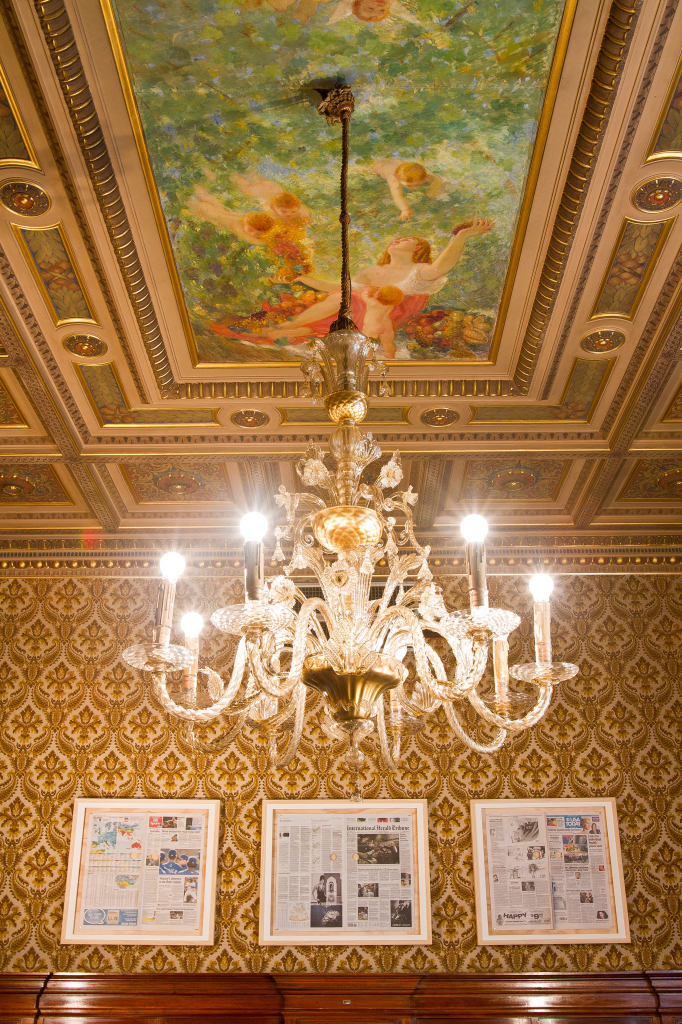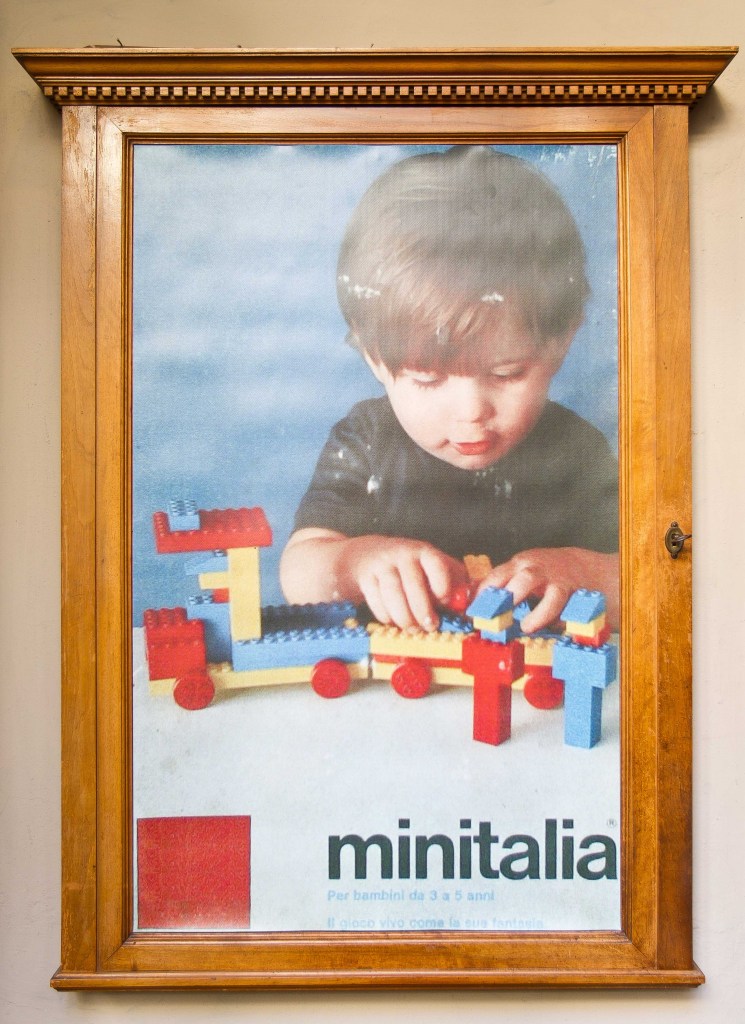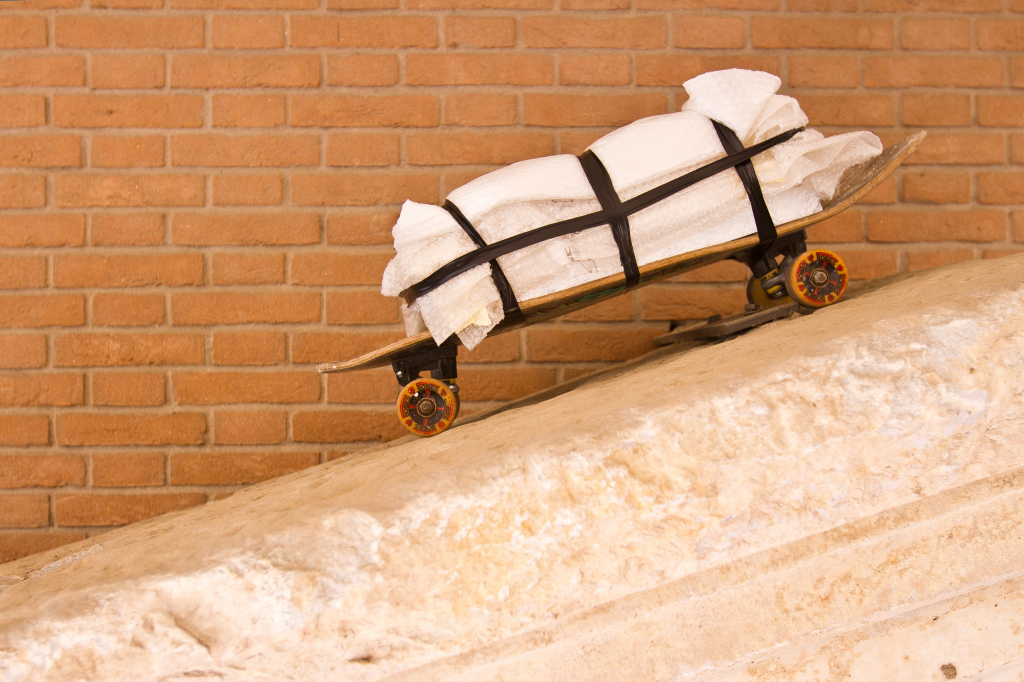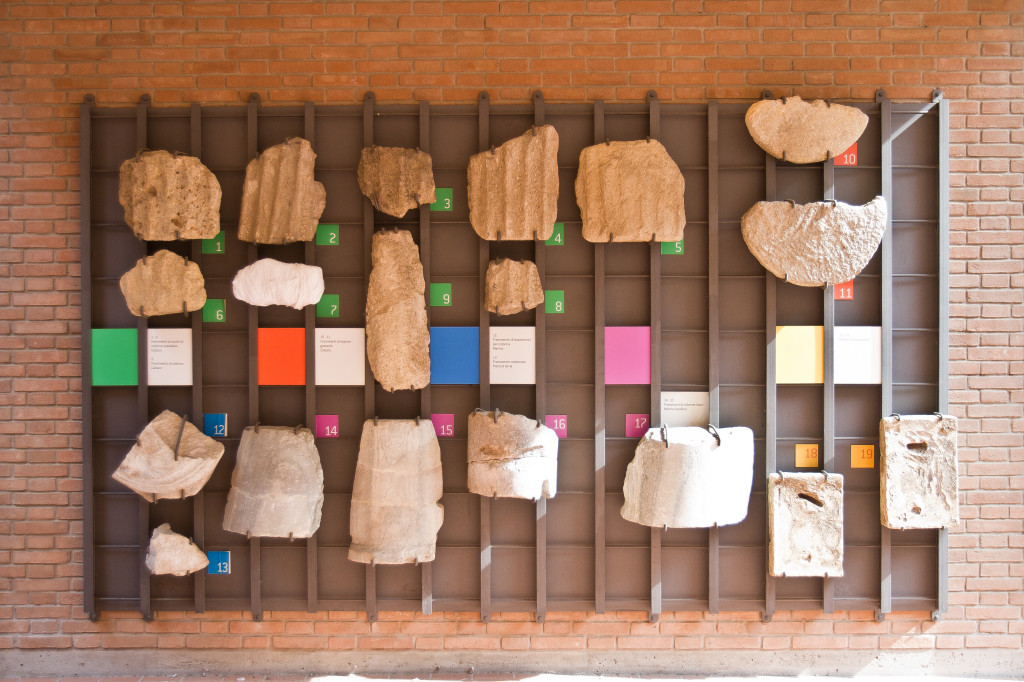Post-real life or hostage/privilege
Banca di Romagna
Faenza/IT
2011
[part one]

people watching, 2009/11 | perforated newspaper | real dimensions

detail from | people watching, 2009/11
GUIDE FOR USE ⊗ Nero
people watching _ The hole, the absent matter, the symbol used once again. The newspaper is pierced in order to make two holes that could be used by a spy for shadowing the movements of the spied on. A voyeur could dream up about some unfortunate or just control his goal to achieve. This hypothesis comes from fantasy, even if it is not too far from reality.

ONLY BIBLE, 2010 | modified book | cm 20,5 x 14 x 3,5
GUIDE FOR USE ⊗ Nero
ONLY BIBLE _ From HOLY to ONLY. A religious symbol turns from sacred into “unique”, as if it wanted to firmly raise its religiousness. Inside the burgundy leather cover with letters impressed in gold, we find a “unique” Bible.

come/come, 2011 | solvent ink print on PVC | cm 216 x 154

come/come, 2011 | solvent ink print on PVC | cm 216 x 154
GUIDE FOR USE ⊗ Nero
come/come _ Hypothesis of static helplessness over the system. Poetic fragment extracted from an industrial area. Pun of the English and Italian pronunciation of the word “come”, in a conceivable endless rhythm.

mini italia, 2011 | solvent ink print on PVC | cm 56 x 91

mini italia, 2011 | solvent ink print on PVC | cm 56 x 91
GUIDE FOR USE ⊗ Nero
mini italia _ That is Italy without growth, caged. It is amazing how an old game of foreigner production can have been so far-seeing in fully interpreting the current condition of the Bel Paese.

installation view | la nuova tradizione, 2011 | solvent ink print on PVC, earthenware vases, white paint | variable dimensions
GUIDE FOR USE ⊗ Nero
la nuova tradizione/globalization _ In the hall of decision-making control (of the Bank) the topic of the day is the retail of tableware and the troubles that could occur during the transport of the aforesaid goods. Post-real action.

exhibition view | Banca di Romagna

TFR/trade funeral ruin, 2011 | an old stone pediment slope fragment, skateboard, plastic packaging, insulating tape | cm 272 x 385 x 103
GUIDE FOR USE ⊗ Nero
TFR/trade funeral ruin _ Trade. Funeral. Ruin. The acrobatic severance pay is nothing but an “expulsion” from the stage.

piece of satellite, 2011 | old stones, plastic packaging | cm 250x 370 x 55
GUIDE FOR USE ⊗ Nero
piece of satellite _ New millions of satellite pieces fallen on Earth will add to the millions of old stones kept by mankind.
Aesthetic capital
Sibilla Zandonini
The principles and rules of democracy are irrelevant to the nature of Italian people who do not care about politics […] The big mass of the Italians is individualist […] Mussolini was right when he said that Italians have always been poor people”.
(D’Arcy Osborne, British Minister to the Vatican, November 1943)
Have the Italians always been poor people?
We are poor people who see only what is convenient. We enjoy watching from behind the newspaper, we make two round holes and we look beyond goggling because beyond we do not find anything.
Once upon a time there was a substratum of subversion in the poor jargon. In 1967 Germano Celant, introducing his rebellious artists, wrote about revolution, acts rich in social significance, art merging with life, action as liberation . The poor art was born.
I have always looked with suspicion at this close past, as if it was a too heavy burden for our contemporary scene. That conceptual trend to which many young artists are still prone, turns too often into something similar to the enthusiastic “It could work” shouted by Dottor Frederick Frankenstein/Gene Wilder in Young Frankenstein by Mel Brooks. Nero, however, keeps its poetical feature and its challenging will, bringing the language up to date. He keeps the enthusiasm of the experimentation but he detaches from easy and foregone classification.
In 1957, ten years before the poor art was born, t he Sit uat ionis t s shook Par is w it h all t heir détournements. Destabilizing acts whose purpose was creating new connections bet ween objects and places, a sort of readymade by Duchamp applied to the situations and not to the objects. For example, the bank that turns into a museum is a perfect détournement, a shift that nowadays is almost necessary in the poor Italy and Nero, in his peculiar way, gives it ill-gotten gains of the failed revolutions back.
In 1962 Raoul Venigem wrote “nowadays a rich person is someone who has the largest number of poor objects”. It was fifty years ago but the social attention is still directed only to the market. What is important is how much merchandise you can afford and not how many ideas you can have. And yet the word “merchandise” stems from the Latin “merere” which means “ deserve”. Clearly we are victim of a big bluff.
Nero does not tell anything but this story that seems to wrap on itself. Hidden behind every clue we find the cornerstones of our society, symbols of powers that we, poor Italians, observe in silence because with the passing of time we have got convinced that all this is normal or even fair. Works are like the bread crumbs of Pollicino that lead us home, to that mini italia imprisoned behind the china cabinet. I am afraid that as long as the cupboard is beautiful and the china cabinet clean we will stay there, hung to the notice board playing with bricks with that look of amazement. Italians, poor people.
Maintenance
a conversation between Alberto Zanchetta and Nero/Alessandro Neretti
AZ: In your second last solo exhibition That’s hole Folks! in 2010, you confessed wanting to deal with “the topic of economic interests that boost big countries to turn their goals into real holes”, explaining that “plundering and devastating seem to be the prerogative to modify what could be managed as economic and social operations”. On that occasion you exhibited a series of works named Homework in which an unusual icon recurred, “the shopping cart”, consumerism symbol that identified with social, political and religious troubles. That’s hole Folks! introduced a miscellany of works that did not cope only with economics, whereas Post-real life or hostage/privilege is based on this subject. How has the awareness and urge of dealing with such a thorny matter for the topical interest matured in the last year?
N: The series Homework was born in 2009 as a personal desire to realize social and financial architectures that could analyse some concepts typical of the contemporar y economics thanks to the use of recurring shapes, icons and messages pertaining to our daily life.
In this exhibition, instead, I extracted/showed concepts, personal thoughts settled in my notes since many years and which built my secret world, made of simple images.
The “ homework”, as usual, is the spontaneous or forced reflection, raising consciousness of part of the system and its many facets, the sudden effort made by the brain to finally devote to the global human metaphor.
By the means of the series of works displayed in London at the exhibition Heavenly Creatures last year and in particular making use of zoomorphic sculptures and wooden frames, I faced the most personal theory stating that economy is the psychologist of the world. Only taking a hard look on economy and letting her settle down on a couch, we can understand which could be its direction, developments and also our expectations. We will know much more about that at the end of the session , but not as much to be sure of its actions.
As far as your question is concerned, I think that the current affairs are thorn for the economy.
AZ: During the conception of this exhibition I have noticed a particular emphasis on words like “deception” and “deceit” which underline your attempt to invalidate the real, with the need to plagiarize or at least deform the meaning of the images. You admit having conceived the works as “a cheating to the detriment of body and mind”. Would you mind defining more exactly what do you mean by post-real and which meaning do you assign to the pair hostage/privilege that appears in the title of the exhibition?
N: Post-real is all we have just experienced and we are experiencing instant by instant. I like to define it as such because in our minds it is still vivid but, actually, it has already moved somewhere else.
Post-real can be a counterfeit event as the cruel reality, which for its same extravagance evolves in something mystified, an altered present. Post-real is what we imagine to live and what we see/generate with our mind.
A lot of images are conceived with a lo-fi(1) technique, so as to make real this muffled effect that wants to be and stay distant from our conscious part, a clear sensation in the story that seems blurred when we reproach to go into details.
The pair hostage/privilege and the dichotomy that arises when we read this two words together makes me happy and at the same time dims my happiness annihilating me incredibly.
We think not to take part of it, we think that it affects only other people, but it is not true, we are all hostages, constantly, even if we are not aware of it. We are taken hostage by the politics, the market, the development, the State, money, our choices, vices and virtues.
When we try to give a distress signal , everyone nods but the reality is always the same, all remains unchanged. It is not kidnapping, it is a “pure privilege”. If we say thank you, probably we do not make a boor of ourselves.
AZ: We are living a period of economic crisis that involves all the occidental world and there is a real danger that the society and politics collapse under the overwhelming burden of the recession. How does the fact that the project houses in a bank institute influence your work?
N:There are a lot of parameters to fulfil of course, and using them in my favour is enormously pleasant, most of all if you have always tried to elude them as I do.
The works and their concepts are selected between many ideas in order to give the more exhaustive and comprehensive reading of my social economic view.
So, I looked for a series of subtle inputs that could partly get in touch with the occasional consumer who makes use of the bank and of its ends. Partly I produced real visions, images rooted in the current affairs that are soaked with concepts.
Talking about something else would have been useless, the economy and the social could not stay out of this project side/site-specific that seized the most suitable stage, an excellent stage. It would be the same in the case we would critically study the Word of God in a catholic cathedral.
In banks I have always seen displayed works that did not reflect the place predisposition, but in this case this relation exists because the works live the space and thanks to it they are perceived by the consumer.
AZ: In the last decades we have been unwilling witnesses to a cultural subversion. The work of art, once world heritage, has weakened in a private property, in the place of being a good thing for men, art has become a simple consumer good. By now artists are forced to produce more than create. The exploitation of the work and the intellect tends to go along with the consumers’ tastes. The cultural values are redefined as consumption and exploitation value. So, the economy has in its power and holds in check both ethics and aesthetics. In practice, the art system asserts itself as a cultural industry that wants to increase its own capital. The société du spectacle turned the end, that is the art (pour l’art), into a mean that makes profit. Employing Marx’s words, it seems that art has become an opaque wrapping, that is a “commodity” and as such it has to submit to the market laws that base on the principle of the supply and demand. However, art’s purpose is the question about art, in fact it has always had the merit of raising questions, more than providing answers (the question has never been interlocutory, but it asserted itself as the same act of questioning). In particular, which is your thought? Or perhaps should I call the intellectual problem “speculation”, borrowing the term from the economic jargon?
N: About ten years ago when I started to commit myself to art, I thought that the purity and passion, but also the effort and vigour, with which I devoted myself to sculpture or graphics could stay unchanged.
(We live in a crappy unbelievable world).
With the passing of time I dodged blows, asked and even begged for what I was entitled to as of right. Now I have understood that I am creating for myself, for people whether they understand or not, but little for the market because I know that it is very busy and I would never disturb it.
After having visited the bank’s spaces, at first I thought of a plan to empty it deftly but as usual I found myself filling it with a lot of things –in my opinion- which are to be said.
The relation creation/reward or work/money do not have that great poetical meaning that embodied in the past anymore. The industrial commercialization and the economic twists has changed the art system as far as both the demand and achievement procedures are concerned, causing tensions and misunderstandings.
In the catalogue I reproduced a small dictionary in four languages that I consider as a true work of art made of paper. WÖRTERVERZEICHNIS(2) aims at making people think about the concept of work considering/listing some of its tools that are apparently without value but they are fundamental for the survival of the individual and consequently also of the work, the art and the market.
AZ: Let’s continue speaking about the critical method you adopted dealing with the present, but this time in relation to the publication published on the occasion of this exhibition. It is not only a catalogue which illustrates the exhibition, in fact you conceived it as a second thoughts – a reshuffle? Repossession? – of the cultural dynamics…
N: Now that the choices of the State are without future and art, culture and social development are not taken into consideration, in my opinion it is very important to conceive a publication that is not a solo, but an interview with different figures who can state their own view freely.
This was the original idea of the project. I have not been able yet to understand if the project has developed as I imagined it or if it has gone off the rails, beyond, crashing into the reality. In this case it would not be as bad: tackling the failure, all assumes a new perception which, in the end, turns into a confirmation of the post-real theory.
AZ: To conclude, would you like to add something?
N: At present I am looking for new cultural partners, new galleries, new chances, new collectors, new thinkers, new foundations, new inputs, new parallel futures to build together works and concepts that go beyond us and could be more useful than how much we think this very second.
– – – – – –
(1) Lo-Fi is technique of low fidelity sound recording.
(2) Glossary.
